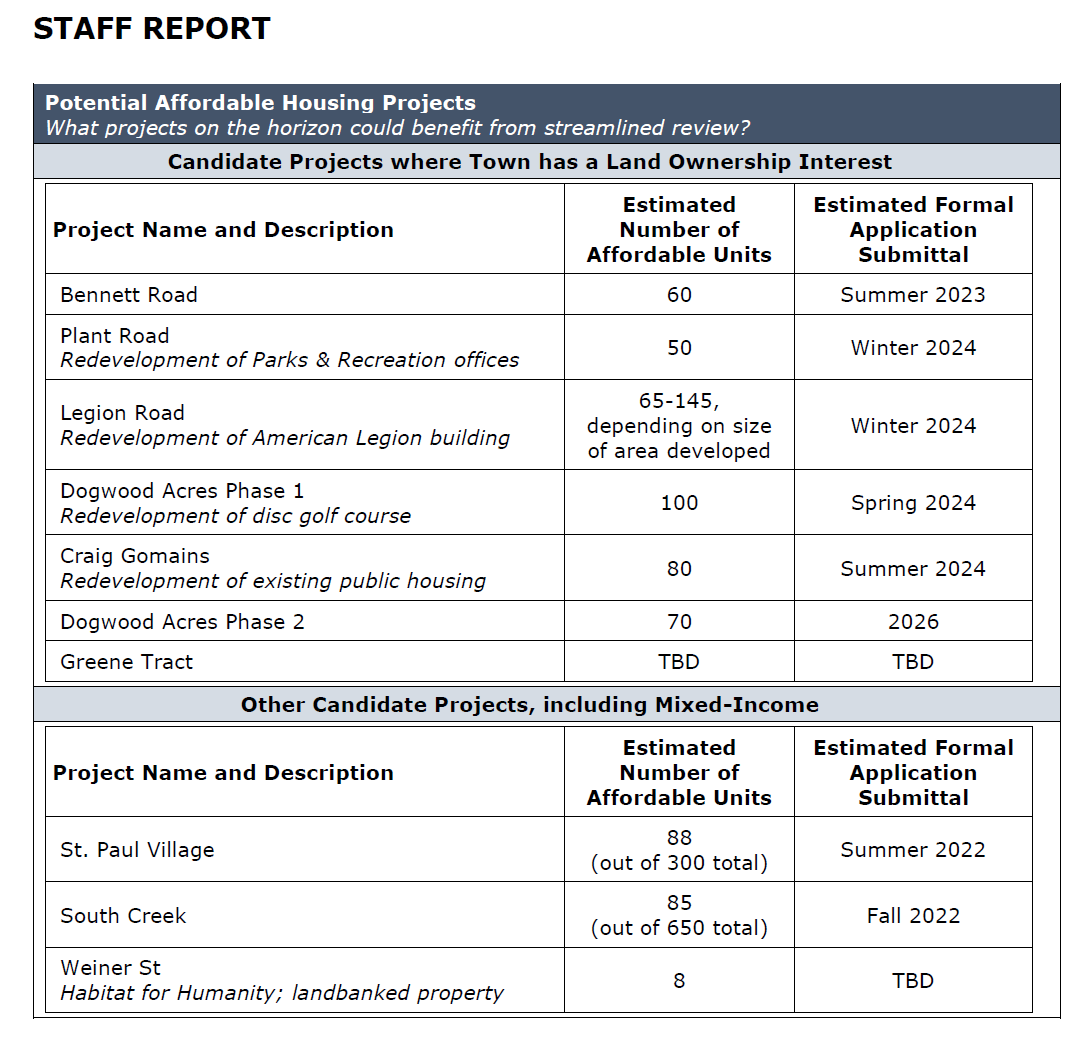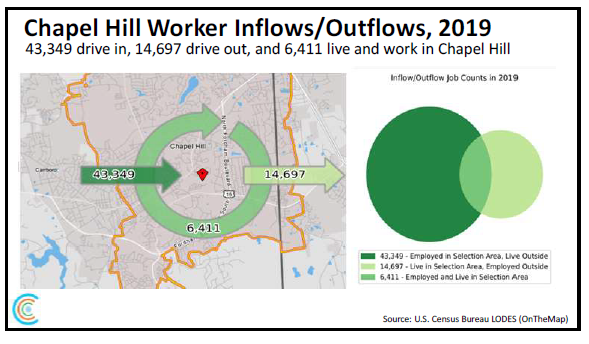It’s Town Council season again, which means our fact-checking fingers are limbering up for a workout.
In a preview of things to come, Chapel Hill Town Council member Adam Searing sent out a Saturday night newsletter entitled “Controversial town topics on tap.”
We’ve previously written about Searing’s claims that Chapel Hill was last in our region in park space when it’s actually first.
His latest newsletter is riddled with inaccuracies and absurd statements, mainly on topics we debunked last year.
Facts: The plan for American Legion is to build a park.
We’ll start with the American Legion land, which Searing devotes several fear-mongering paragraphs to.
As we’ve written before, the plan has ALWAYS been to build a park on the American Legion site.
What actually happened
Last June 1, the Chapel Hill Town Council discussed a petition, written by Council member Michael Parker and signed by four of his colleagues on the Council, to begin a planning process on the future of the American Legion property. (The American Legion property is not now, nor has it ever been, a town park. The petition submitted by the five town council members would help to generate the funding to make it one.)
(For more on the meeting, see Triangle Blog Blog’s recap, Chapelboro’s recap, and The Daily Tar Heel’s recap.)
The petition aligns with Council’s justification for purchasing the American Legion property in 2016. At that time, elected officials resolved to use some of the town-owned American Legion land for park space. Councilmember Parker even proposed an amendment clarifying that the council “did not intend for the entire property to be used as a park and that the town would explore other options through the master planning process.”
This motion passed 8-1, including votes in favor from Mayor Hemminger and Council Members Anderson and Parker. Former council members who supported non-park uses on the site included Nancy Oates who, although she voted against the resolution, suggested Fleet Feet as a potential private retailer on the site… because Council wanted to ensure businesses on the site would “fit in” (June 26, 2017 Town Council meeting).
Facts: About the rest of the park land….
Searing returns to the topic of parks and recreation, claiming his fellow council members have a new “develop the parks” policy to basically take down “parks and preserved land” and put them “up for development.”
Searing is apparently the only council member who is aware of this “plan.”
Searing’s basis for his argument appears to be this cut-off graphic taken from a staff report prepared in May of 2022 which he says is a “memo from Town of Chapel Hill staff that shows the next parks and preserved land up for development.”
That’s not what this document is and it’s not what it shows. First, here’s the full graphic from the report:

What am I looking at?
This graphic is part of a memo prepared by Town staff to expedite review of potential affordable housing projects, some of which were identified by town staff back in June 2018. (You can read all about this on the Chapel Hill Affordable Housing website.) At the time, Town Council asked the Town Manager to prioritize three Town-owned sites for affordable housing — which include land bordering the current Southern Community Park.
But…that’s not the direction the Town Council took at the time. They decided to pursue the Jay Street and Bennett Road developments.
This list Adam shares shows parcels that the Town owns. As the Town Properties Task Force final report states, “The Town of Chapel Hill periodically assesses Town-owned properties to determine how they might be used differently to further the Town’s goals.”
The list Searing shares also includes the redevelopment of existing public housing, the redevelopment of the Parks and Rec offices, and other landbank property. It also includes the Greene Tract. It took 37 years to agree on a plan to put housing on the Greene Tract, Kirk Ross wrote last year.
Also, we have to laugh at his claim that a “formerly secret Town of Chapel Hill memo gives the legal go-ahead for this controversial push” for selling off parkland. Searing knows very well that this memo was requested in response to neighbors’ complaints that the Council was violating the law by transforming the Jay Street site, purchased with open space bond funds, into affordable housing. Council members wanted to make sure they were acting in accordance with the law.
It has nothing to do with some “master plan” to sell off Chapel Hill’s parks, and to claim so is wildly misleading.
Facts: We return to The Greene Tract, again
The Greene Tract is a tract of land that community members who live next to it have fought for decades to develop.
As council started debating the project years ago, opponents of the development started calling the town-owned land the Greene Tract Forest. This was strategic, as others have noted, because it “mak[e]s it seem like the Tract is protected, public land” which it is not and has never been.
We realize Searing joined the Council last year, so he might not be aware of these historical developments, including the town’s periodic assessment of them, but he should be aware of the housing crisis we face.
At the State of the Community, held last week, we learned that our median rents are up, that a larger portion of people’s income is going towards rent, and that 71% of people who work in Orange County commute in.

We’re glad that the Town Council is seriously undertaking efforts to build more housing. (And we’re also happy that we have so much open land here.) We love parks, and it’s nice to know that Chapel Hill continues to lead the Triangle in accessible, inclusive, and – quite frankly- amazing natural spaces.
Facts: Misinformation about 828 MLK Blvd and coal ash
Searing ends his piece looking at 828 MLK Blvd. As we’ve written before, there is a lot of misinformation circulating about the future of 828 MLK Jr. Blvd. This post details what’s happened so far, what the town has decided, and details why the counterarguments circulating right now about the redevelopment don’t stand up to scrutiny.
If you’d like more details, we recommend Mayor Pro Tem Karen Stegman’s blog post on the future of 828 MLK Boulevard, in which she makes very clear that the nine-year-long process to evaluate the site is has been “slow, painstaking, and cautious” and that the “misinformation campaign [around the site] is designed to undermine trust in local government and create anger and fear, rather than to inform and educate about a complex topic.” She also makes it very clear that the Town has not yet made a decision on whether to move forward with housing on the site or not.
One comparison he makes is to the site of UNC’s coal-burning plant, where coal ash deposits were discovered during excavation of a warehouse and removed from the foundation before the building was constructed.
But what he doesn’t tell you is that the report found substantial deposits of coal ash on other parts of the site, none of which was touched.
Facts: Some of us like how the town has developed
Blue Hill was once dominated by a sad, tired collection of strip malls. While the form-based district could use stronger design regulations, overall the impact has been positive.
More than a thousand apartments provide new places to live, the new Booker Creek Basin Park provides a lovely respite, great new ways to get around on foot and by bicycle have been added, and the shopping centers have become revitalized with new stores, both local (such as Guglhupf) and national (such as Aldi and Shake Shack).
We are glad that an abandoned Volvo dealership and an empty, fenced-in parking lot have been transformed into apartments. Let’s keep it going.